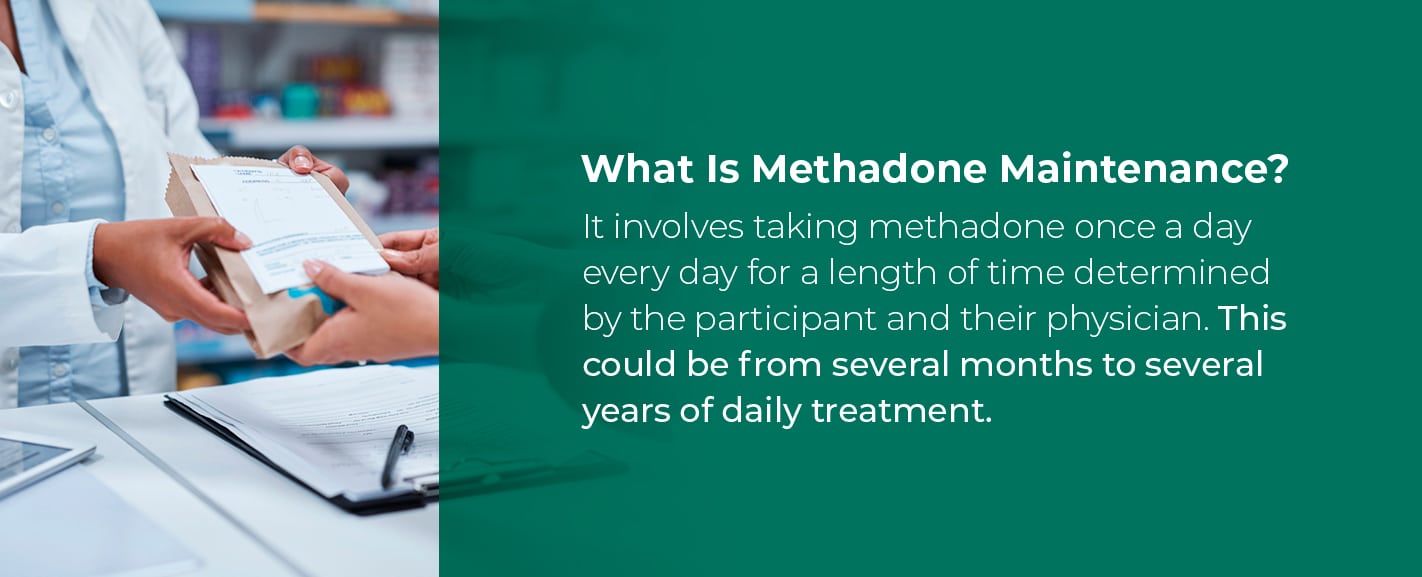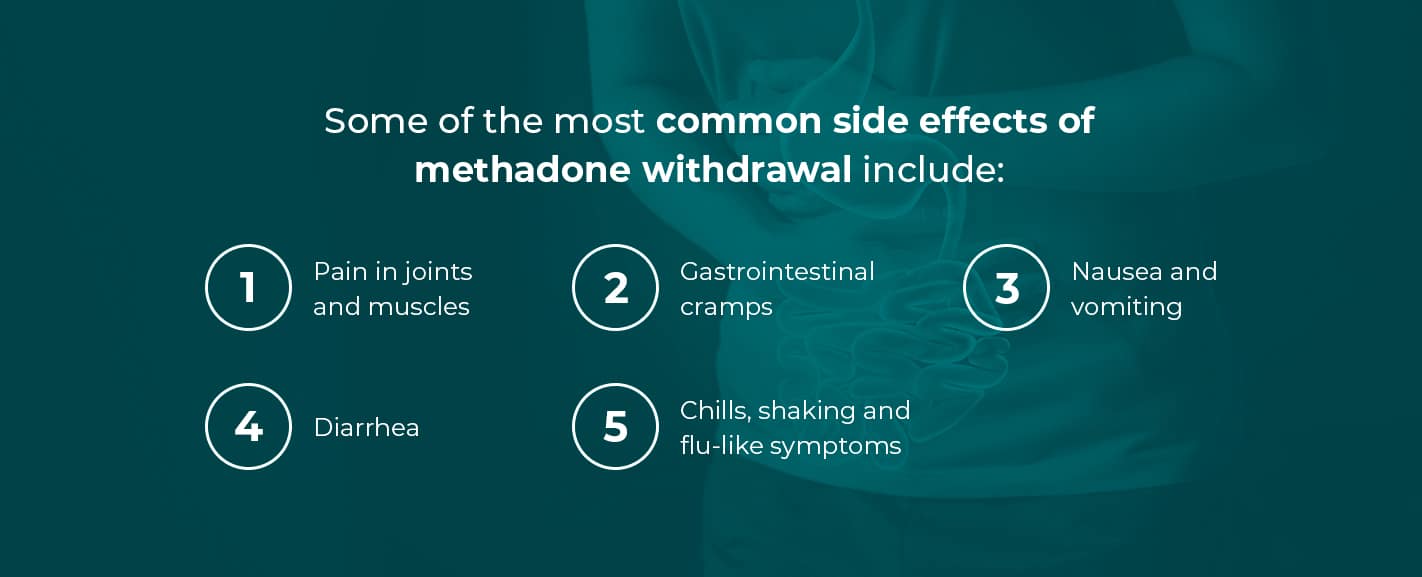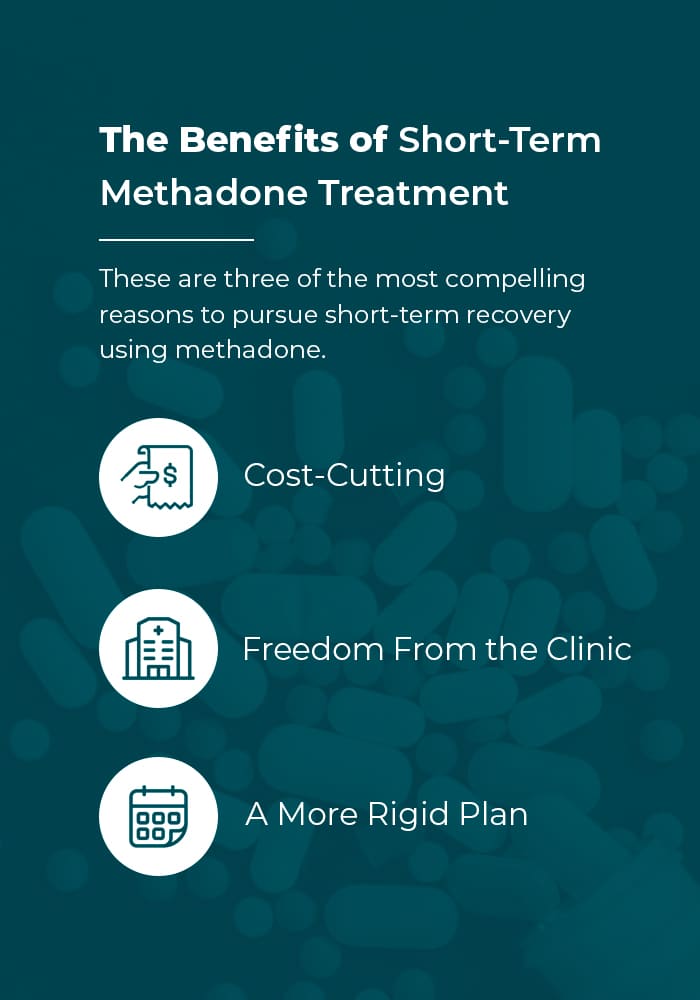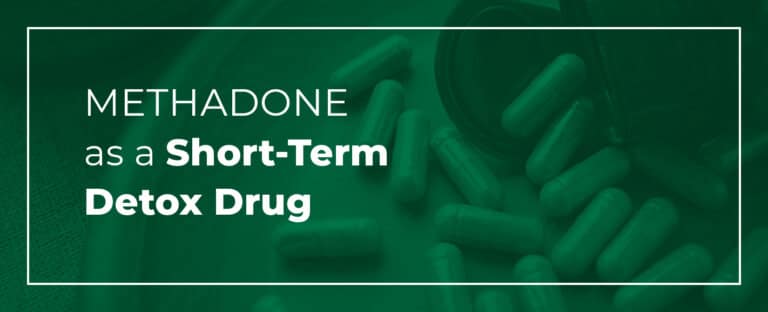Addiction treatment for opioid use disorder comes in many forms. One of those forms is methadone maintenance treatment. As one of the most effective forms of treatment available, methadone maintenance involves taking daily medication for varying lengths of time. The appropriate length of time varies for each individual. Some people do best taking methadone for multiple years, while others only need to become stabilized and then move forward in recovery without medication.
Short-term administration of methadone as a detoxification drug is relatively rare in addiction treatment centers, but it can work well in the right hands. We’ll explore the benefits of methadone, how it works as a short-term detox drug, and why this approach may or may not be suitable for you or a loved one.
What Is Methadone?
Methadone is a synthetic, or man-made, opioid analgesic. It belongs to the same family of drugs that include prescription painkillers like OxyContin® and heroin, but it doesn’t work quite the same way. Similar to those medications, methadone alters the way the brain and central nervous system (CNS) respond to pain, which is why it has historically been used as a painkiller. It was discovered in the 1930s in Germany and introduced to the U.S. in 1947 to treat pain in a multitude of conditions.
Methadone stayed a general painkiller until the 1960s, when it was discovered to be useful in the treatment of heroin addiction. The medication is excellent at relieving many of the painful symptoms associated with opioid withdrawal. Methadone is a “full agonist” opioid, which means it binds to and activates opioid receptors in the brain. Methadone satisfies the need for opioids developed by the brain as a reaction to long-term use of opioid medications or illicit drugs. What makes methadone different than other opioids is its long half-life, meaning its effects can be felt in the body for much longer, often 24-36 hours. This allows one therapeutic dose in treatment to be effective unlike the need to use more frequently with other full agonist opioids.
By satisfying the need for opioids, methadone prevents the body from going into withdrawal. Withdrawal is a state characterized by many unpleasant and painful symptoms including full-body aches, vomiting and cramping, which are often severe enough to lead to immediate relapse. Methadone also reduces cravings for other opioids so the person taking it can focus on participating in therapy, becoming stable and getting their life back.
Methadone can only be obtained legally through an opioid treatment program that has received certification by the Substance Abuse and Mental Health Services Administration (SAMHSA).

What Is Methadone Maintenance?
Methadone maintenance treatment (MMT) is the most common form of addiction treatment with methadone. It involves taking methadone once a day, every day for a length of time determined by the participant and their physician. This could be from several months to several years of daily treatment. The idea behind methadone maintenance is that staying on the medication for the long term will continue to provide the benefits of blocking withdrawal and allowing the patient to remain stable and avoid relapse.
If someone suddenly stops taking methadone, withdrawal will occur, and the individual may attempt to seek out illicit opioids to escape the symptoms. This is why it’s essential for someone taking methadone to stay consistent, and if they want to discontinue the program, work with a provider to slowly taper down the dose. Methadone maintenance programs usually last a minimum of 12 months but can go on indefinitely if an individual and their physician believe the treatment is still playing a positive role in recovery.
The Risks of Long-Term Methadone Treatment
Like any medication, methadone does have its risks. One of the reasons MMT is such a controversial topic is that it’s possible to develop a tolerance to and dependence on methadone. Methadone does not have a ceiling effect and does not lose effectiveness once patients reach a certain dose, making it effective for people who were using high doses of painkillers or stronger drugs like heroin and fentanyl. However, the body still develops a tolerance.
Tolerance is the phenomenon where someone stops responding to a medication or drug in the way they did initially. Once a tolerance has built up, it takes more of the substance to produce the same effects the individual experienced initially. If methadone is administered at the correct levels for a patient, tolerance may not increase. However, the longer a person remains in MMT, the greater the chance they will need dosage adjustments and therefore the greater the risk of developing tolerance — which is one component of addiction.
Physical dependence on methadone is also possible. Dependence is a state in which the brain and body can only function normally when a particular substance is present. When someone is dependent on a drug and it is suddenly taken away, they will begin experiencing the series of extremely unpleasant physiological reactions known as withdrawal.

Methadone Withdrawal and Side Effects
Methadone is not without its drawbacks. There are a variety of withdrawal effects that match those of other opioids, including prescription painkillers and heroin. Some of the most common side effects include:
- Pain in joints and muscles
- Gastrointestinal cramps
- Nausea and vomiting
- Diarrhea
- Chills, shaking and flu-like symptoms
These withdrawal symptoms range from mild to severe depending on a variety of factors. One of the challenges in starting a patient on methadone is determining whether the effects are due to withdrawal from the opioid of abuse or from too low a dosage of methadone. Closely monitoring the individual clarifies this question.
Methadone also comes with a few potential side effects even in the short term. Methadone’s short-term effects include:
- Restlessness or agitation
- Pupil dilation
- Nausea and vomiting
- Itchiness
- Excess sweating
- Respiratory depression
These side effects are normal and usually do not become too severe. However, an individual receiving treatment may feel concern or distress at experiencing them. In some cases, such as when methadone causes nausea, the person may feel like they are entering withdrawal and begin to panic, potentially triggering dangerous drug cravings. A good methadone treatment program will explain all the potential side effects before beginning treatment to avoid such occurrences and adjust the dosing until each patient reaches a comfortable, therapeutic dose.

The Benefits of Short-Term Methadone Treatment
Short-term detox using methadone has a variety of benefits over MMT. These are three of the most compelling reasons to pursue short-term recovery using methadone.
1. Cost-Cutting
Unfortunately, budget considerations are often essential when choosing what course of addiction treatment to pursue. According to the National Institute on Drug Abuse, the cost of methadone treatment is around $126 per week. This cost includes the medication itself, as well as medical support services like visits with a physician, and the estimate assumes daily visits.
It’s important to consider the cost of methadone treatment in the broader context of drug addiction. Continuing illicit opioid use is extremely expensive, and the costs associated with health care related to chronic opioid abuse can be immense. Within this frame of mind, medication-assisted treatment (MAT) with methadone is cost-effective. However, some people simply cannot afford the financial commitment required for long-term methadone treatment even with the assistance of insurance.
Short-term methadone treatment may make individuals more comfortable from a financial perspective, as it allows for much more specific budget planning.
2. Freedom From the Clinic
One of the downsides to methadone is that administration must happen daily at a licensed clinic. This daily routine is helpful in establishing accountability and is required to fulfill federal restrictions on the dispensation of the medication. Over time, participants in an MMT program can earn the privilege of taking home a certain amount of medication. Current federal regulations list these as criteria for receiving take-home methadone:
- Absence of recent abuse of drugs, including alcohol
- Regular clinic attendance
- Absence of serious behavioral issues
- Absence of recent criminal activity
- Stability in the patient’s home environment
- Assurance that the medication can be stored safely
If the individual meets the criteria, these are the amounts of medication that may be taken home.
- First 90 Days: One dose per week
- Second 90 Days: Two doses per week
- Third 90 Days: Three doses per week
- Remainder of First Year: Six-day supply
- After the First Year: Two-week supply
- After Two Years: One month supply
While it’s possible to reduce the number of visits a person must make to the clinic, it takes a long time to do so. Short-term methadone treatment allows individuals to taper off of methadone so they don’t have to attend a clinic indefinitely.
3. A More Rigid Plan
Many people get nervous about the open-ended nature of MMT. They may be uncomfortable with the idea of pursuing a treatment that could go on for an unspecified amount of time. Short-term methadone detox generally has a set end date. This may require slight adjustment, but the end goal is always to taper off methadone completely.
Dosing and Administration of Short-Term Methadone
Finding the correct dosage of methadone for each individual depends on a variety of factors including age, weight and duration of opioid use. At first, a physician must find an adequate dose to minimize withdrawal symptoms and keep the person as comfortable as possible. The typical starting dosage is between 10 and 20 mg of methadone, which is increased 10 mg at a time until withdrawal symptoms have adequately diminished.
Once the person being treated is stabilized, the process of tapering begins. The physician will gradually reduce the individual’s methadone dosage in one of two ways. The first is to decrease methadone intake by 5 mg per day until zero is reached. The second is to decrease by 10 mg per day until 10 mg per day is reached, and then continue to zero dosage in increments of 2 mg per day.
When short-term methadone detoxification takes place in a residential program, the process usually takes five to seven days. Outpatient treatment at a clinic takes longer as the individual is not under constant supervision and finding the right dose is more challenging. Short-term methadone detox at a clinic usually takes a minimum of seven days and may be extended up to 30 days or longer depending on how the individual responds to the physician’s tapering plan.
Is Detox Without Using Methadone Dangerous?
It can be if not done properly. The symptoms of opioid withdrawal are very rarely life-threatening in a direct sense, but combinations of symptoms can lead to hospitalization. The longer someone has abused an opioid, and the stronger that opioid is, the greater the chance of experiencing severe withdrawal symptoms.
For example, someone who used oxycodone for a few weeks might only experience mild nausea and some gastrointestinal upset. Someone else who frequently used heroin for years, on the other hand, would likely experience copious vomiting and diarrhea. The combination of these two severe symptoms could induce dehydration dangerous enough to require a trip to the emergency room for fluids.
The most prevalent danger of detox without the assistance of methadone or another treatment medication is relapse. Without medical intervention, drug cravings can easily become magnified and spiral out of control, leading people to back into illicit opioid use before recovery even has a chance to begin.
Medication-assisted treatment ensures individuals are as comfortable as possible as drugs of abuse leave the system. Methadone treatment makes it possible for people to safely detox from opioids without having to participate in an inpatient program.
Short-Term vs. Long Term Methadone Treatment
Is methadone short-term or long-term treatment better for you or your loved one? There is no cut and dry answer to this question, as every individual and their addiction are different. Many individuals with the most severe addictions benefit from ongoing MAT. A history of relapse is another indicator that long-term maintenance treatment is appropriate.
Personal preference and lifestyle also factor into the decision. Someone who travels frequently for work, for example, may have difficulty with the low frequency of take-home methadone available to program participants in the first year of treatment. In cases like these, it may be a better option to choose a short-term detox over long-term maintenance treatment.
The greatest factor in which treatment you select is how it will support your recovery. Only a physician or other certified medical professional can gather and evaluate the information necessary to make a medically-informed choice of treatment. They have your health and success in recovery in mind and can identify influencing factors you may not have even considered. Medical advice is always critical in formulating a plan for treatment and recovery.
Explore Methadone Treatment With MedMark
Methadone has been considered the gold standard of opioid addiction treatment since the 1970s, for one very good reason — it’s highly effective in supporting recovery and preventing relapse. If you or someone you care about are struggling with addiction to painkillers, heroin or another opioid, methadone can be an invaluable tool. MedMark Treatment Centers provide evidence-based methadone treatment for opioid addiction, and we offer short-term methadone detox for those who need it in select locations.
MedMark has locations in multiple states ranging from coast to coast. To get your questions answered or get in contact with the clinic nearest you, call us today at (866) 840-6658. Alternatively, you can reach out through our contact form. The medical experts at MedMark will walk you through the pros and cons of the various treatment forms we offer, including those that use methadone. With medical assistance, counseling and referrals to local resources, you can carve out a path to recovery from opioid addiction. Don’t hesitate — call today.




